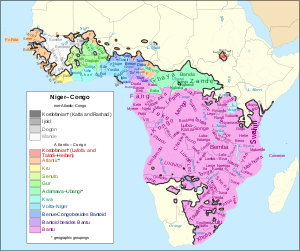Atlantic–Congo languages
| Atlantic–Congo | |
|---|---|
| Geographic distribution | Africa |
| Linguistic classification |
|
| Subdivisions | |
| ISO 639-5 | alv |
| Glottolog | atla1278[1] |
|
The Atlantic–Congo languages shown within the Niger–Congo language family. Non-Atlantic–Congo languages are greyscale. | |
The Atlantic–Congo languages are a major division constituting the core of the Niger–Congo language family of Africa, characterised by the noun class systems typical of the family. They comprise all of Niger–Congo except Mande, Dogon, Ijoid and the Katla and Rashad languages (previously classified as Kordofanian). Mukarovsky's West-Nigritic corresponded roughly to modern Atlantic–Congo.
In the infobox at the right, the languages which appear to be the most divergent (Senufo, Kru) are placed at the top, whereas those closer to the core (the similar Benue–Kwa branches of Kwa, Volta–Niger and Benue–Congo) are near the bottom.[2] The erstwhile Atlantic branch has been broken up into Senegambian, Bak, Mel, Gola and Limba, which are left next to each other merely because there is no published evidence to move them; Volta–Congo (Savannas through Benue–Congo) is intact apart from Kru and Senufo. If Kwa or Savannas prove to be invalid, the tree will be even more crowded.
There are a few poorly attested languages, such as Bayot and Bung, which may prove to be additional branches.
Glottolog (2013) does not accept that the Kordofanian branches (Lafofa, Talodi and Heiban) or the difficult-to-classify Laal language have been demonstrated to be Atlantic–Congo languages. It otherwise accepts the family, but not its inclusion within a broader Niger–Congo.[1]
References
- 1 2 Hammarström, Harald; Forkel, Robert; Haspelmath, Martin; Bank, Sebastian, eds. (2016). "Atlantic–Congo". Glottolog 2.7. Jena: Max Planck Institute for the Science of Human History.
- ↑ Roger Blench, Niger-Congo: an alternative view
